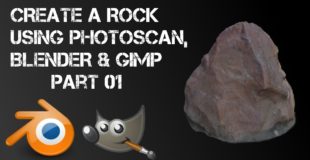https://i.ytimg.com/vi/VJYuid0ow48/hqdefault.jpg
In this tutorial we create a rock for our video game using Photogrammetry.
Follow Cryonetic on Facebook:
https://www.facebook.com/Cryonetic
Support me on Patreon:
https://www.patreon.com/PaulSwartz?ty=h
Follow me on twitter:
https://twitter.com/PaulSwartZZZ
Website:
http://www.cryonetic.com/
source

17 responses to “3D model using Photoscan and Blender – Part 01 – SCANNING”
Awesome videos man, can you tell me how much ram do you need to scan those rocks?? I need to build a PC specific to scan rocks AND reconstruct walls
a black screen in my agi soft before and after adding photos..what should i do? I have the standard version…
followed step by step, the materials never import.
Nevermind it was breaking when I was changing it to Cycles.
had to redo the nodes and reset the texture.
Does having the Pro version affect the quality? I'm doing the same thing you are but it's coming out like mud. Pain in my arse… Any ideas?
Awesome vid! Really got me interested in Photoscan!
2:14 – You may know this, but if the dense cloud cuts pieces off you should change the filter setting.
Also, on this link: https://dinosaurpalaeo.wordpress.com/2015/10/11/photogrammetry-tutorial-11-how-to-handle-a-project-in-agisoft-photoscan/
There are some usefull info, specially that you can change the photo tie points limits to 0 for unlimited tie points and then use the Gradual selection to remove badly aligned points and then use that magic wand to realign the photos. It really helps for some models.
Is that program compatible with Mac or is there any similar program I can use?
Thank you so much for this video series. I'm just starting to watch it, but I can see that it has the workflow at Blender as well, which is the harder part in my opinion. And no video shows it. Almost a year watching some tutorials and trying stuff, still barely knows how to load a model to blender and nothing about fixing it. Also nice to see a fast agisoft workflow for a change.
4:10 If you build the mesh from a dense point cloud, you can later select the mesh, go to tools and use "Decimate Mesh" option, it lowers the size back while retaining the detail.
Just watch out that you will need to remake the textures after that process. My file got reduced from 2 million faces to 200k and size from 215 M to 20M
great! 🙂
I have been looking for a way to get my photoscans into blender to do just that for a while! Thanks for the video
nice job, camera setting please??
Awesome video dude! Thank you! A fellow South African?
Does that software use GPS or gyroscope metadata contained in the images to orient the photographs in 3D space? Or just the pictures are enough from any camera?
The UI of your blender looks much better than mine thanks to the blueish parameter input boxes.
very awesome video!
great job ty